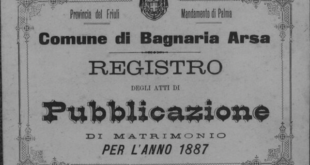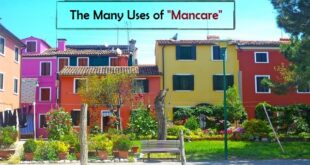Care lettrici e lettori, saluti da Roma! My name is Claudia Bortolani and I’m an attorney licensed to practice law in Italy and California. I’m a partner in Aliant Law, an international firm that provides assistance with all aspects of Italian law for its clients in Italy and abroad, including the U.S. Fra Noi has invited me to launch a column in which I answer question that Americans commonly ask about Italian law, whether they’re vacationing in Italy or buying a home there. I look forward to sharing my expertise with you. Let’s start with a basic question in real …
Read More »Reaching for the stars
The readers of Fra Noi never cease to amaze me. Any time I’ve asked you to lend a hand in times of need, you’ve come through in spades. When you learned a couple of months ago that inflation had taken its toll on our bottom line, you didn’t miss a beat. Hundreds upon hundreds of you — more than 10% of our total readership — opened up your hearts and your pocketbooks, filling our coffers with funds sufficient to cover a mind-boggling 80% of our projected deficit for the year. Week after week, white envelopes have flooded into the Fra …
Read More »15 years, just like that!
I eagerly await the coming of September every year, but this year feels special because it marks 15 years since I took over penning this column. I’ve covered topics ranging from the good old days of church processions and carnivals to the good times we had at the favorite places of our youth, like “The Ave” (Michigan Avenue). Many of the topics I’ve covered have resulted in online discussions and real-life visits to the nostalgic locations those columns mentioned. The greatest source of information and inspiration for this column is conversations and discussions I’ve been a part of. As everyone …
Read More »10 things to bear in mind
When starting on your home-buying adventure, there are many factors that folks often overlook until it’s too late. Cell Signal — Let’s face it, most homeowners are ditching landlines. If you rely on a cell phone for just about everything, check around indoors and out for your reception and service compatibility. Ask your provider to diagnose the cell signal. There are ways to improve tower communication should there be an issue. Water — Unless you’re a cold shower enthusiast, which also seems to be trending, you don’t want to find out the hard way that your hot water is nonexistent or …
Read More »Before they tied the knot
Last month, I explained how our ancestors married people from their town of birth a large percentage of the time. This was a byproduct of transportation difficulties, and the custom of arranged marriages, among other reasons. So before entering the once-indissoluble state of Holy Matrimony, a series of documents were assembled to verify that the marriage would be legitimate and could not be challenged. One type of document was the marriage banns, known in Italy as the pubblicazioni. These were used to tell the town that these two people wanted to marry (or their parents wanted them to marry), and …
Read More »1950s docudrama reenacts post WWII workplace tragedy
A tragic story based on true events, Giuseppe De Santis’ 1952 “Roma ore 11” (Rome 11:00) follows several young women in post-WWII Rome as they answer a single job listing for a typist. When 200 women are in line on one staircase spanning several floors, a crack leads to the collapse of the entire staircase. Dozens were injured, and one person was killed. The tragedy spoke to the poverty and desperation of so many Italians in the early 1950s before the ’58 industrial boom began. The prolific screenwriter Cesare Zavattini contributed to the script, which was based on testimonials. Filmmaker …
Read More »The many uses of mancare
The Italian verb mancare has many meanings: to miss (someone)/to need (something)/to lose/to lack/to be lacking/to omit/to fail and can even be used as a euphemism for to die. Perhaps the most common way Italians use the verb mancare is to convey the idea of “to miss someone,” which was discussed in detail in a previous blog in this series, ” ‘Missing You’ with Mancare” In the prior blog, the conjugation of mancare and the use of indefinite object pronouns needed to convey the idea of “missing someone” was discussed in detail. With this blog, we will now focus on the …
Read More »Filmmaker, musician follow in the footsteps of Kerouac
An independent short film that follows a musician as he follows in the footsteps of iconic beat poet Jack Kerouac is receiving praise on the national film festival circuit. Produced by songwriter and first-time filmmaker Dru DeCaro, “Destination Angels” rides along with DeCaro’s longtime friend and fellow musician Christopher Mansfield, aka Fences, as he embarks on a journey of self-reflection while paying tribute to his literary hero. The adventure begins when Fences receives a call from Jim Sampas, Kerouac’s nephew and head of his estate. The conversation prompts Fences and DeCaro to head north up California’s Route 1, retracing Kerouac’s …
Read More »What’s new around Pullman
My July column focus on the Pullman Reunion Picnic, which we all look forward to on the first Saturday of every August. However, I’ve just received notice that, due to unforeseen issues, this year’s picnic has been cancelled. The people I’ve spoken to have said that they plan on coordinating next year’s picnic, but we’ll verify that next year as the event approaches. I apologize if anyone has made plans to attend this year’s picnic, however there is still much to see in Pullman. The neighborhood has become an official national park and is now known as the Pullman National …
Read More »Home buying, step by step
Buying your first home can be a stressful experience and the best way to tackle it is by taking it a step at a time. First, you will have to figure out your needs, wants, and your budget. This will guide you through each step of the process. It is important to determine these things in the beginning, so you don’t waste your time on the wrong things. The home buying process can be a long one. A home is so much more than the looks and location. Next, you must do your own research. This includes reading up on …
Read More » Fra Noi Embrace Your Inner Italian
Fra Noi Embrace Your Inner Italian











